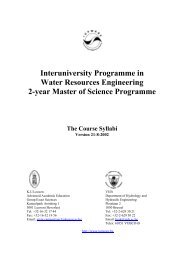CFHT operating manual - Homepage Usask
CFHT operating manual - Homepage Usask
CFHT operating manual - Homepage Usask
Create successful ePaper yourself
Turn your PDF publications into a flip-book with our unique Google optimized e-Paper software.
<strong>CFHT</strong> Observatory Manual - Observatory (Sec.5) http://www.cfht.hawaii.edu/Instruments/ObservatoryManual/CFH...<br />
At the beginning of 1998, an upgraded version of the Gumball calibration unit was<br />
commissioned at <strong>CFHT</strong>. Not only optomechanics and electronics components were<br />
modified or changed but a new Pegasus interface was also implemented. For an<br />
observer, the major changes include the possibility to define different exposure times<br />
for each lamp for the same calibration frame, pre-defined setups for diverse<br />
intrumental configurations to optimize the utilisation of the Gumball, and the<br />
availability of two Fabry-Perot interferometers providing regularly spaced calibration<br />
lines over large spectral ranges. See the Gumball Web Page for more information.<br />
LAMA<br />
LAMA (LAzer MAchine) - This is a Micro-Control YAG laser driller, which has<br />
been installed by <strong>CFHT</strong> in 1990, with the help of the Observatoire de Marseille.<br />
Maximum size of the drilling section is 150x150mm.<br />
Currently for the MOS/SIS, we are using 75 microns thick, black anodized,<br />
commercial aluminum wafers. The practical limit for the minimum width of the slits<br />
is 0.25 arc sec. at f/8. Residual r.m.s. drilling errors on the slit edges are about 2<br />
microns.<br />
With recent refinements of the system, especially the adoption of a travelling<br />
salesman algorithm to speed up transfer time of the x-y stage from one slit position to<br />
another, drilling time, including data transfer to the LAMA controller, is typically 20<br />
minutes for 150 slitlets (say 1.5 arc sec. x 12 arc sec. each). To this value, one must<br />
add ~10-15 minutes for various overheads, quite independent of the number of slits.<br />
Note that these values are quite comparable to typical integration time (except for<br />
very faint objects), and the observers are strongly encouraged to plan their observing<br />
sequences as well as possible. In particular, during long MOS/SIS multi- slit runs, it<br />
makes sense that each observer makes a couple of images for his/her successor, so<br />
that a run can start with a few masks already quietly made during the day.<br />
9 of 10 08/07/04 11:26 PM

















